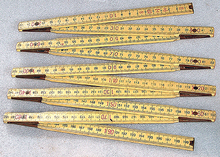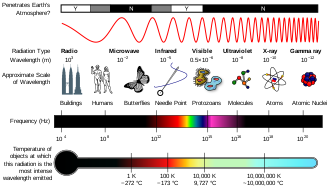| centimetre | |
|---|---|
 A carpenter's ruler with centimetre divisions A carpenter's ruler with centimetre divisions | |
| General information | |
| Unit system | SI |
| Unit of | length |
| Symbol | cm |
| Conversions | |
| 1 cm in ... | ... is equal to ... |
| millimetres | 10 mm |
| imperial & US system | ~0.3937 in |

A centimetre or centimeter (US/Philippine spelling), with SI symbol cm, is a unit of length in the International System of Units (SI) equal to one hundredth of a metre, centi being the SI prefix for a factor of 1/100. Equivalently, there are 100 centimetres in 1 metre. The centimetre was the base unit of length in the now deprecated centimetre–gram–second (CGS) system of units.
Though for many physical quantities, SI prefixes for factors of 10—like milli- and kilo-—are often preferred by technicians, the centimetre remains a practical unit of length for many everyday measurements; for instance, human height is commonly measured in centimetres. A centimetre is approximately the width of the fingernail of an average adult person.
Equivalence to other units of length
1 centimetre = 10 millimetres = 0.01 metres = 0.39370078740157477 inches (There are exactly 2.54 centimetres in one inch.)
One millilitre is defined as one cubic centimetre, under the SI system of units.
Other uses
In addition to its use in the measurement of length, the centimetre is used:
- sometimes, to report the level of rainfall as measured by a rain gauge
- in the CGS system, the centimetre is used to measure capacitance, where 1 cm of capacitance = 1.113×10 farads
- in maps, centimetres are used to make conversions from map scale to real world scale (kilometres)
- to represent second moment of areas (cm)
- as the inverse of the Kayser, a CGS unit, and thus a non-SI metric unit of wavenumber: 1 kayser = 1 wave per centimetre; or, more generally, (wavenumber in kaysers) = 1/(wavelength in centimetres). The SI unit of wavenumber is the inverse metre, m.
Unicode symbols
For the purposes of compatibility with Chinese, Japanese and Korean (CJK) characters, Unicode has symbols for:
- centimetre – U+339D ㎝ SQUARE CM
- square centimetre – U+33A0 ㎠ SQUARE CM SQUARED
- cubic centimetre – U+33A4 ㎤ SQUARE CM CUBED
These characters are each equal in size to one Chinese character and are typically used only with East Asian, fixed-width CJK fonts.
See also
References
- "Decimal multiples and submultiples of SI units". Bureau International des Poids et Mesures. 2014. Retrieved 5 July 2015.
- "Using the BMI-for-Age Growth Charts". cdc.gov. Centers for Disease Control. Archived from the original on 30 January 2014. Retrieved 5 July 2014.
- Price, Beth; et al. (2009). MathsWorld Year 8 VELS Edition. Australia: MacMillan. p. 626. ISBN 978-0-7329-9251-4.
- "Rain Measurement". www.weathershack.com.
- Weisstein, Eric W. "Capacitance -- from Eric Weisstein's World of Physics". scienceworld.wolfram.com.
- CJK Compatibility excerpt from The Unicode Standard, Version 10.0.
External links
| Metric units of length (by order of magnitude) | |
|---|---|
| From smallest to largest (left to right). Commonly used units shown in bold italics. | |
|
| CGS units | |
|---|---|
| Base units | |
| Derived non EM units | |
| Derived EMU units | |
| Derived ESU units | |